

Arctic Summer Sea-Ice a Thing of the Past. Evidence continues to mount that climate change has pushed the Arctic into a new state.
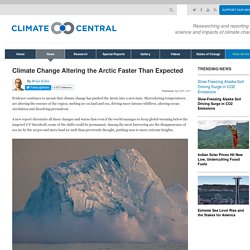
Skyrocketing temperatures are altering the essence of the region, melting ice on land and sea, driving more intense wildfires, altering ocean circulation and dissolving permafrost. A new report chronicles all these changes and warns that even if the world manages to keep global warming below the targeted 2°C threshold, some of the shifts could be permanent. Among the most harrowing are the disappearance of sea ice by the 2030s and more land ice melt than previously thought, pushing seas to more extreme heights. An iceberg collapses, Disko Bay, West Greenland.
Credit: Carsten Egevang/arc-pic.com. Glacier National Park Now Glacier-Free. Greenland Experiencing Ice-Free Summers. AP Photo/Matt York At this point, you're probably fully aware of how hot it is.
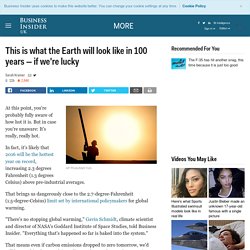
But in case you're unaware: It's really, really hot. In fact, it's likely that 2016 will be the hottest year on record, increasing 2.3 degrees Fahrenheit (1.3 degrees Celsius) above pre-industrial averages. That brings us dangerously close to the 2.7-degree-Fahrenheit (1.5-degree-Celsius) limit set by international policymakers for global warming. "There's no stopping global warming," Gavin Schmidt, climate scientist and director of NASA's Goddard Institute of Space Studies, told Business Insider. That means even if carbon emissions dropped to zero tomorrow, we'd still be watching human-driven climate change play out for centuries.
This is what the Earth could look like within 100 years if we do, barring huge leaps in renewable energy or carbon-capture technology. Far Northern Permafrost Releasing Carbon. By Carol Rasmussen, NASA's Earth Science News Team Permafrost in the coldest northern Arctic — formerly thought to be at least temporarily shielded from global warming by its extreme environment — will thaw enough to become a permanent source of carbon to the atmosphere in this century, with the peak transition occurring in 40 to 60 years, according to a new NASA-led study.
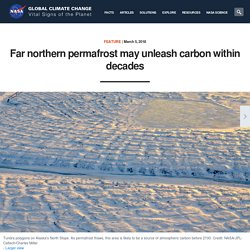
The study calculated that as thawing continues, by the year 2300, total carbon emissions from this region will be 10 times as much as all human-produced fossil fuel emissions in 2016. The study, led by scientist Nicholas Parazoo of NASA's Jet Propulsion Laboratory in Pasadena, California, found that warmer, more southerly permafrost regions will not become a carbon source until the end of the 22nd century, even though they are thawing now. That is because other changing Arctic processes will counter the effect of thawing soil in these regions.
Melting Tibet Glaciers Lead to Climate Refugees in Downstream Countries. 30% of Himalayan Ice Cap Lost. At least a third of the huge ice fields in Asia’s towering mountain chain are doomed to melt due to climate change, according to a landmark report, with serious consequences for almost 2 billion people.
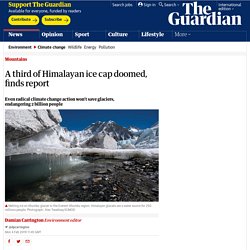
Even if carbon emissions are dramatically and rapidly cut and succeed in limiting global warming to 1.5C, 36% of the glaciers along in the Hindu Kush and Himalaya range will have gone by 2100. If emissions are not cut, the loss soars to two-thirds, the report found. The glaciers are a critical water store for the 250 million people who live in the Hindu Kush-Himalaya (HKH) region, and 1.65 billion people rely on the great rivers that flow from the peaks into India, Pakistan, China and other nations. “This is the climate crisis you haven’t heard of,” said Philippus Wester of the International Centre for Integrated Mountain Development (Icimod), who led the report.
NZ Southern Alps Lose 75% of Pre-Industrial Ice Coverage. In Franz Josef village, climate change has a sound and a smell.
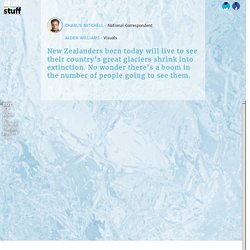
It is the sound of heavy machinery passing overhead, rotor blades slicing the air. It is the smell of aviation fuel swirling in the village. Franz Josef only has 330 ratepayers, but it now boasts 15 helipads from which aircraft lurch into the sky, over Lake Wombat and into the Waiho valley, ferrying visitors back and forth from the glacier. As soon as the noise of one helicopter dissipates, another arrives to fill the empty space; sometimes they seem to move in pairs. Glacier Country is not only one of the busiest air spaces in New Zealand, it’s likely one of the busiest in the world. During peak times, there can be as many as one flight per minute at Franz Josef. Landings per hour Landings in the Westland Tai Poutini National Park have increased significantly since 1995.
The constant drone of helicopters has given the once silent valleys a loud thrum similar to that of living by a motorway. “It's that Apocalypse Now feeling.”